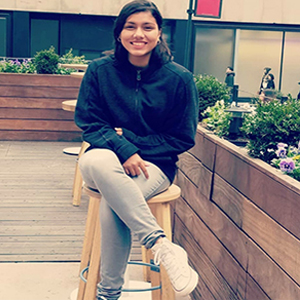Trina 's Story
About the Experience
How was your
overall experience?:

How was your
overall experience?:
Joan H. and Preston Robert Tisch Center at Essex Crossing
171 Delancey Street
Suite 210
New York, NY 10002
NYU Langone Orthopedic Associates — Lake Success
1999 Marcus Avenue
Suite 202
New Hyde Park, NY 11042
NYU West Palm Beach
1601 Forum Pl
West Palm Beach, FL 33401
Trina Tanuj
As a young girl from India, swimming was the one sport that stole my heart from the beginning. “You're half fish”, my friends and family would joke. After swimming for almost 10 years and competing at a national level in India, unfortunately, towards the end of 2016, a terrible fall during practice would lead me on a different journey.
Interestingly enough, I didn’t quite feel the magnitude of pain that I should have felt. In fact, minutes after the fall, I was already getting back up and running again. It was a few hours later when I noticed my left ankle swelling up to the size of a tennis ball.
I was given an initial diagnosis of an ankle sprain by local orthopedic doctors and advised to rest for a few weeks. However, as weeks went by, my ankle started to progressively get worse, especially when I applied my entire body weight onto it. It soon became apparent that I needed to get some further imaging done.
The MRI and X-ray findings had suggested that I had developed an Osteochondral Lesion of the Talus bone. Local Doctors had suggested that I immobilize my ankle in an aircast for 6 weeks. 6 weeks had soon turned into 12 weeks, after which the numerous doctors I visited had offered either of the suggestions: continue using an air cast for another 6 weeks or surgery.
My dad, who was living in the United States at the time, had decided that it would be better if we got an opinion of a more specialised foot and ankle surgeon in New York City. After meeting Dr. John Kennedy and his team of doctors, we were presented with a few courses of treatment such as the OATS procedure, ACI, Microfracture and the Trapdoor procedure. By the end of the meeting, it was quite clear that my family and I wanted to proceed with the trapdoor procedure. Although other doctors had preferred the other procedures, we felt that the trapdoor procedure would give me the best chance at preserving my entire cartilage and lead to a quick recovery.
Though I was living in India at the time, my family and I felt that it would be best for Dr. Kennedy and his team to perform the surgery. After the surgery, I was quite amazed to be healing really quickly. It took about 6 to 8 weeks for me to be back in the water and with about a few months of physical therapy, I was back to running, something doctors in India warned I could potentially never be able to do again.
Although the surgery was a success, I developed a small cyst in the subchondral region of my talus. When it started showing symptoms the following year, Dr. Kennedy and his team had recommended that a PRP was the best way to take care of this issue. Surprisingly, the PRP gave me instant relief, something I wasn’t expecting to notice so soon. The following year, the cyst present in my ankle started to become symptomatic again. We again followed the course of treatment recommended, a second round of PRP this time in India, along with some proprioceptive and stabilization exercises through physical therapy. Eventually, the second PRP controlled the symptoms I was having and allowed my ankle to heal fully. Fast forward to today, a surgery and 2 PRPs later over the span of 3 years, my ankle has finally gotten the range of motion and strength I had before my injury. I’m extremely thankful to Dr. Kennedy and his team for getting me back on my feet, quite literally, to doing the things I love to do best.